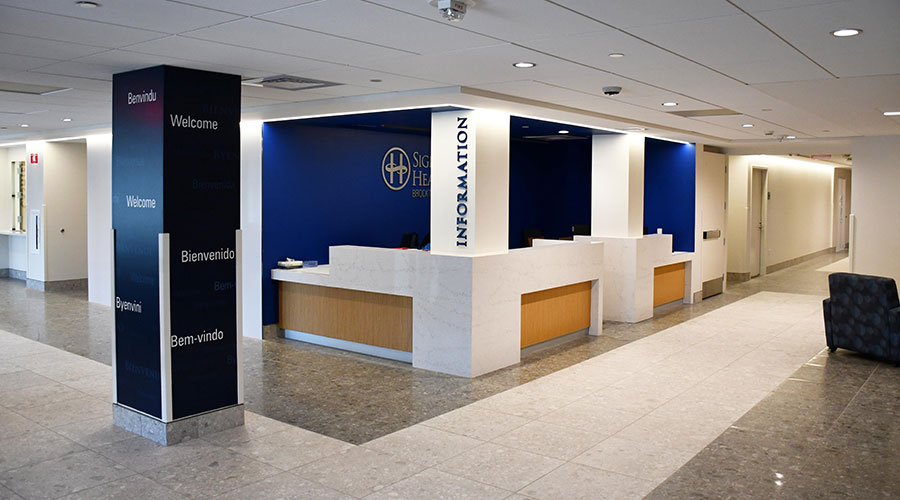A number of forces have brought the issue of acoustics to the attention of healthcare organizations, the most recent of which is the link the Value-Based Purchasing (VBP) program has drawn between patient satisfaction scores and Medicare.
In an effort to address noise and speech privacy concerns, many facilities are installing sound masking systems. This technology essentially consists of a series of loudspeakers installed in a grid-like pattern in the ceiling, as well as a method of controlling their zoning and output. The loudspeakers distribute an engineered background sound, raising the facility’s ambient level.
The premise behind this solution is simple: any noises that are below the new background sound level are covered up and the impact of those still above it is lessened because the degree of change between baseline and peak volumes is smaller. The frequency and severity of disruptions to patients’ sleep and staff’s concentration is diminished. Similarly, conversations are either entirely masked or their intelligibility is reduced, improving privacy.
Most people have experienced this effect when running water at their kitchen sink while trying to talk to someone in the next room. They can tell the other person is speaking, but it is difficult to comprehend what they are saying because the running water has raised the background sound level in their area. Examples are, in fact, endless: the sound of an airplane engine, rustling leaves, the murmur of a crowd in a busy restaurant. All have the potential to mask sounds the listener would otherwise hear.
Of course, when introducing a masking sound to a healthcare facility, it is vital to ensure that it is as effective, comfortable and unobtrusive as possible. Otherwise, the sound runs the risk of becoming a source of irritation and rather than solving a problem, it becomes part of it, as was the case with ‘white noise’ systems in the early 1970s.
Preparing a sound masking specification or evaluating an existing document can be challenging, but the payoff is worth the effort. These systems typically have a long lifespan and one can end up living with their selection for quite some time. The best approach is to focus on the six qualities that are critical to effectiveness, comfort and future flexibility:
Adjustment zone size
The single most important factor is to place an upper limit on the size of the adjustment zones (i.e. groups of individually controllable loudspeakers).
Small zones of one to three loudspeakers (225 to 675 ft2) allow the masking sound’s volume and frequency to be adjusted according to local conditions, ensuring effective levels and uniformity across the space. If, on the other hand, the system features larger zones, eight to dozens or even hundreds of loudspeakers (1,800 to 22,500 ft2 or more) are set to the same volume and frequency. As a result, compromises must be made. For example, if the volume needs to be increased to improve the system’s effectiveness in one area, it might be too loud in another.
Masking sound generation
Each small zone should have a dedicated masking sound generator in order to avoid a problem called phasing or uncontrollable variations in masking levels, which occurs when a number of adjacent loudspeakers emit the same masking signal.
Each masking generator should provide a sound that is random (i.e. no repeat cycle). The sound must also cover the entire masking spectrum of 100 to 8000 Hz in order to provide both comfort and effectiveness, and mask a wide range of noises.
Volume and frequency adjustment
Regardless of how the system’s loudspeakers are installed (i.e. upward-facing, above a suspended ceiling or downward-facing, cut through a ceiling), the masking sound will be affected by other elements of the design, including the materials used in the space, the location on the floor, items above the ceiling, and furnishings. Therefore, the specification should call for fine volume controls of 0.5 dB for each zone.
If the system’s volume cannot be finely adjusted in local areas, it can only be set to a level that is best ‘on average,’ compromising comfort or effectiveness at various unpredictable points across the space. Occupants will notice volume peaks and troughs as they move through the space. Furthermore, one can usually expect a 10 percent reduction in performance for each decibel below the target masking volume, halving the system’s effectiveness in some areas.
Similarly, the system should also provide fine frequency control within each zone. The range should be specified to be between 100 to 8000 Hz and control over these frequencies should be via third-octave adjustment, which is the industry standard and basis for masking targets set by acousticians.
Loudspeaker requirements
Loudspeaker drivers should be 4 to 8 inches (100 to 200 mm) in diameter and rated from 10 to 25 watts in order to ensure they can generate the low frequencies that are vital to occupant comfort.
Control methods
The type of control the system offers is critical in healthcare settings for two reasons.
First, providing a patient (or staff) with the ability to locally adjust the masking volume in their room not only improves comfort, but increases a patient’s sense of control over their environmental conditions, raising satisfaction levels. The system should not only offer this type of local control, but also provide administrators with the ability to set a maximum (and perhaps minimum) volume that cannot be exceeded in these areas.
Second, a system that offers networked control from a central panel or computer will allow changes to be made to settings and zones without reopening the ceiling. This feature is important because, if not properly handled, opening the ceiling has the potential to spread microbiological contaminants, as well as dust, fibers and odors, into the occupied space below.
Measured results
The process should not end as soon as the sound masking system is selected. The true gauge of whether it is performing as expected is gained from measurements done after installation and initial tuning.
If there is an acoustical engineer on the project, they will typically specify a masking curve with overall volume and tolerances.
However, generally speaking, the specification should require a test in each 1000 ft2 (90 m2) area and that the vendor adjust the masking sound within that area as needs dictate. Masking volume is typically set to between 40 and 48 dBA, and the results should be consistent within an overall range of 1 to 1.5 dBA or less, unless local variation is desired in specific areas (e.g. individual patient rooms). The specification should also set a maximum variation for each third-octave frequency band in the masking spectrum. Plus or minus 2 dB is a reasonable expectation.
In conclusion
With these six performance-based factors forming the framework for the specification, one can easily add other requirements, the importance of which varies by project (e.g. appearance the loudspeakers in an open ceiling), application (e.g. occupant controls in patient rooms) or geographical region (e.g. UL 2043 compliance in the United States). Lastly, learn what services the vendor offers in support of their system and appoint a ‘guardian’ who will ensure that all bids meet the established criteria.
Get a sample of a generic performance-based sound masking specification.
Niklas Moeller is vice-president of K.R. Moeller Associates Ltd., a global developer and manufacturer of sound masking system, LogiSon Acoustic Network (www.logison.com). He also writes a weekly acoustics blog called “UnMasked – an inside look at acoustics.”

 Case Study: How NYU Langone Rebuilt for Resilience After Superstorm Sandy
Case Study: How NYU Langone Rebuilt for Resilience After Superstorm Sandy Frederick Health Hospital Faces 5 Lawsuits Following Ransomware Attack
Frederick Health Hospital Faces 5 Lawsuits Following Ransomware Attack Arkansas Methodist Medical Center and Baptist Memorial Health Care to Merge
Arkansas Methodist Medical Center and Baptist Memorial Health Care to Merge Ground Broken on Intermountain Saratoga Springs Multi-Specialty Clinic
Ground Broken on Intermountain Saratoga Springs Multi-Specialty Clinic Electrical Fire Tests Resilience of Massachusetts Hospital
Electrical Fire Tests Resilience of Massachusetts Hospital